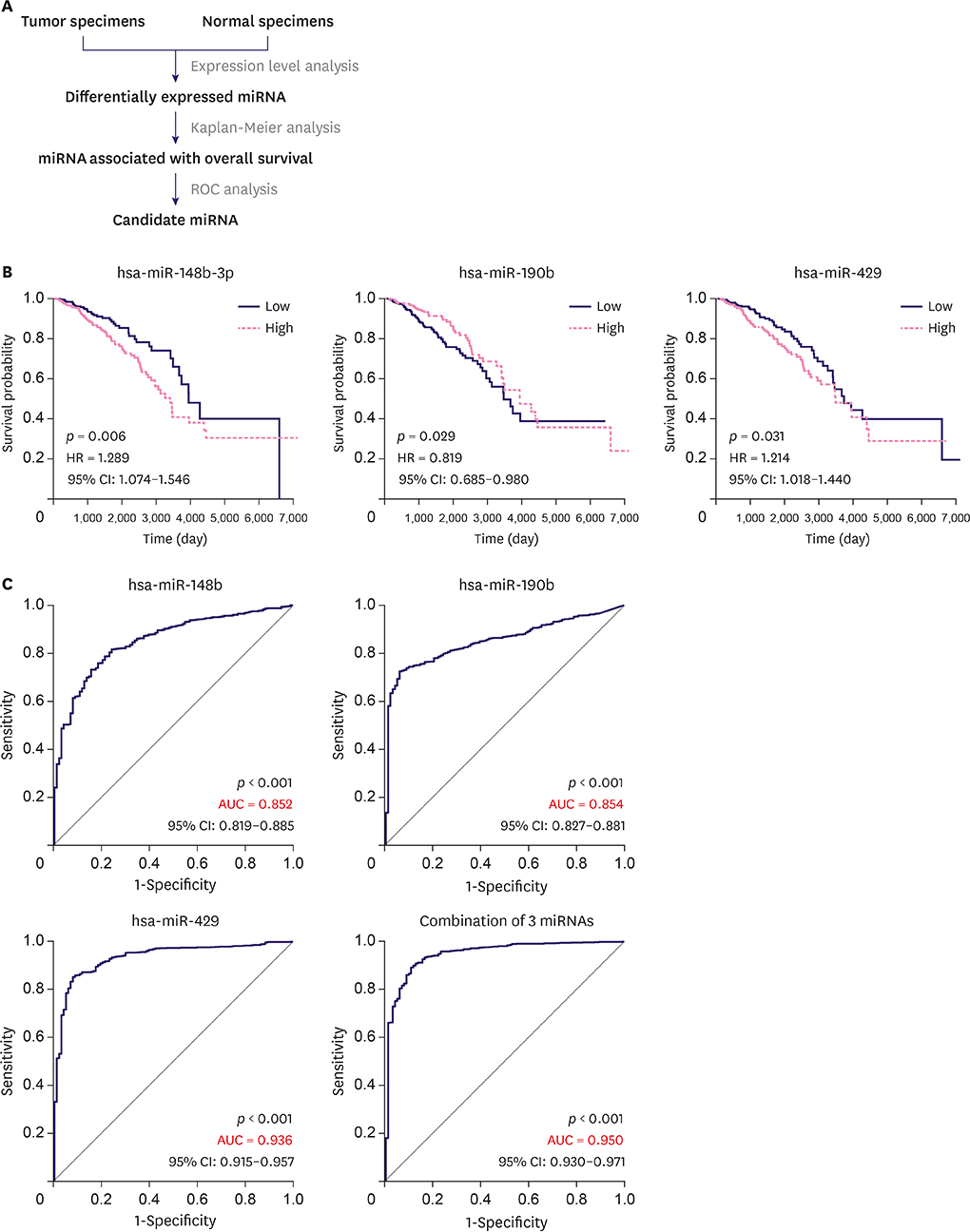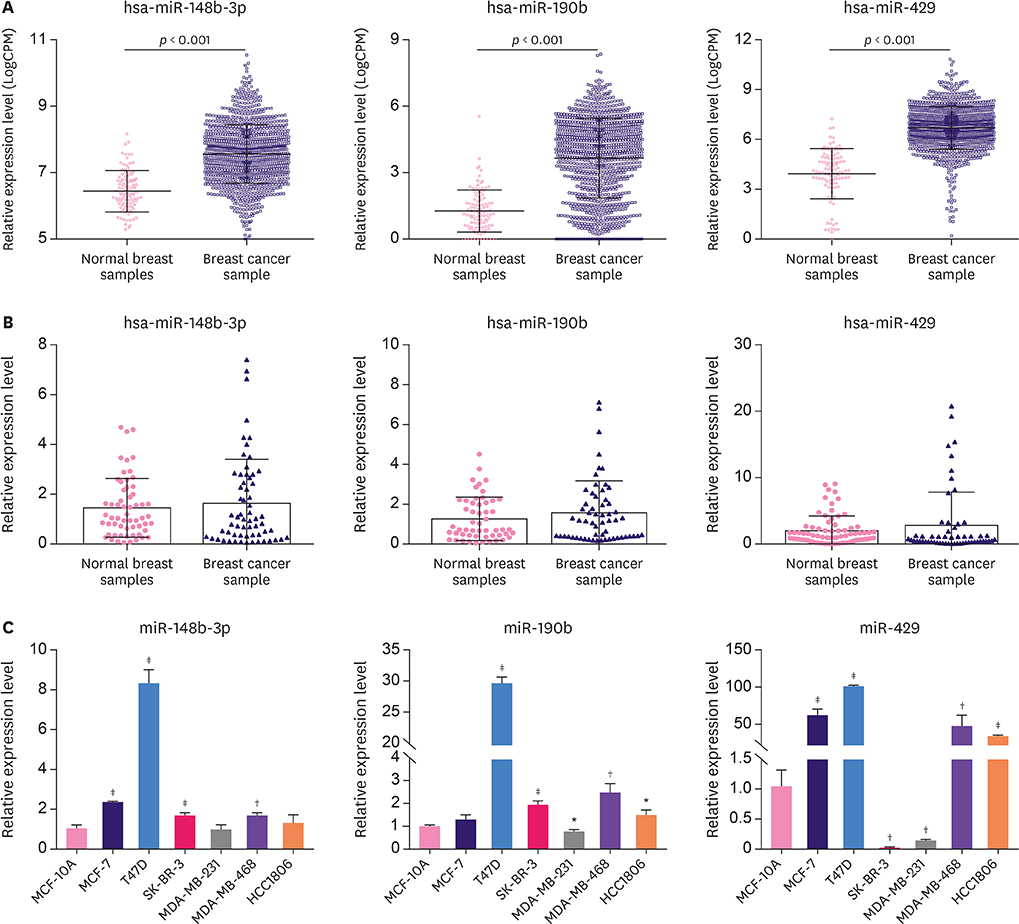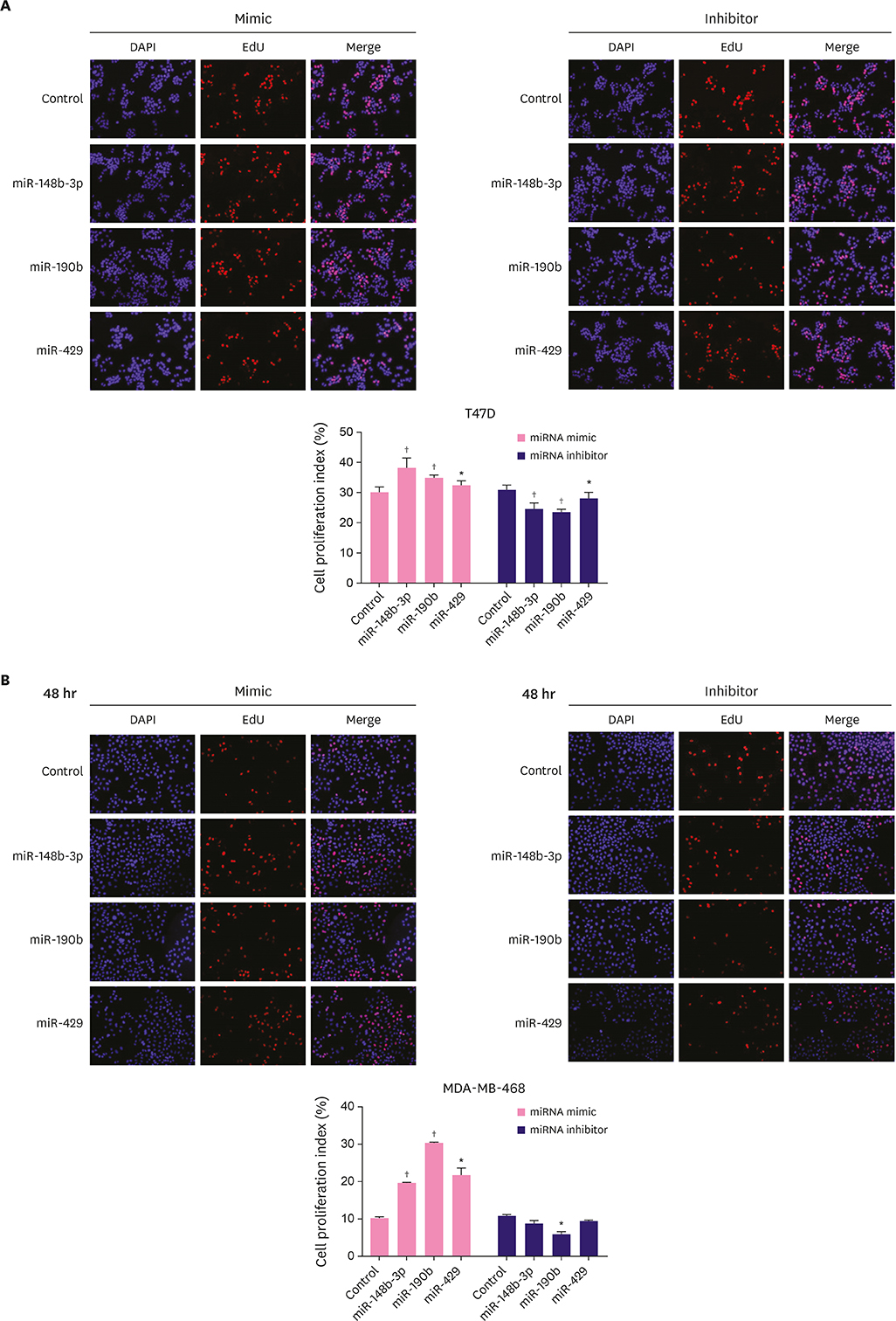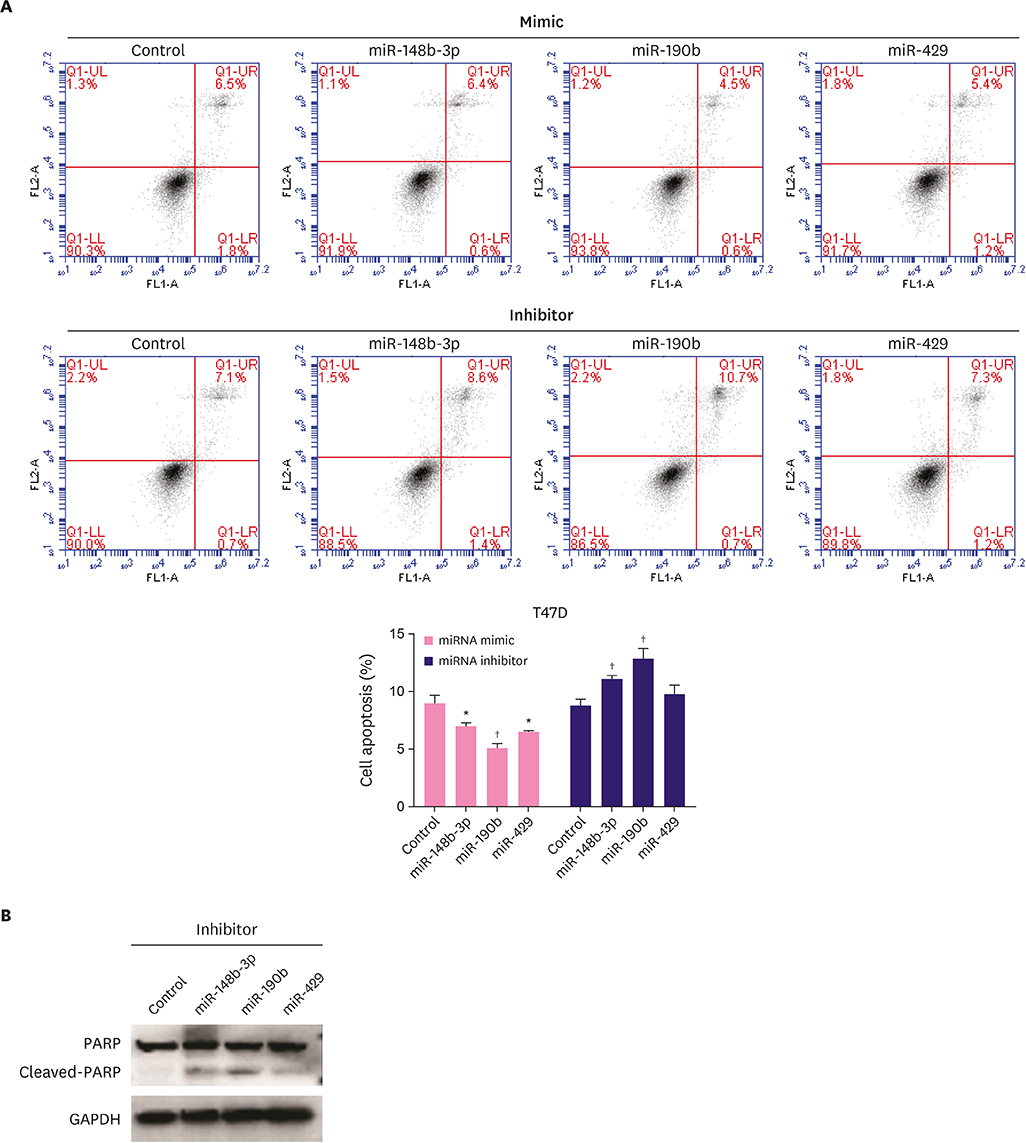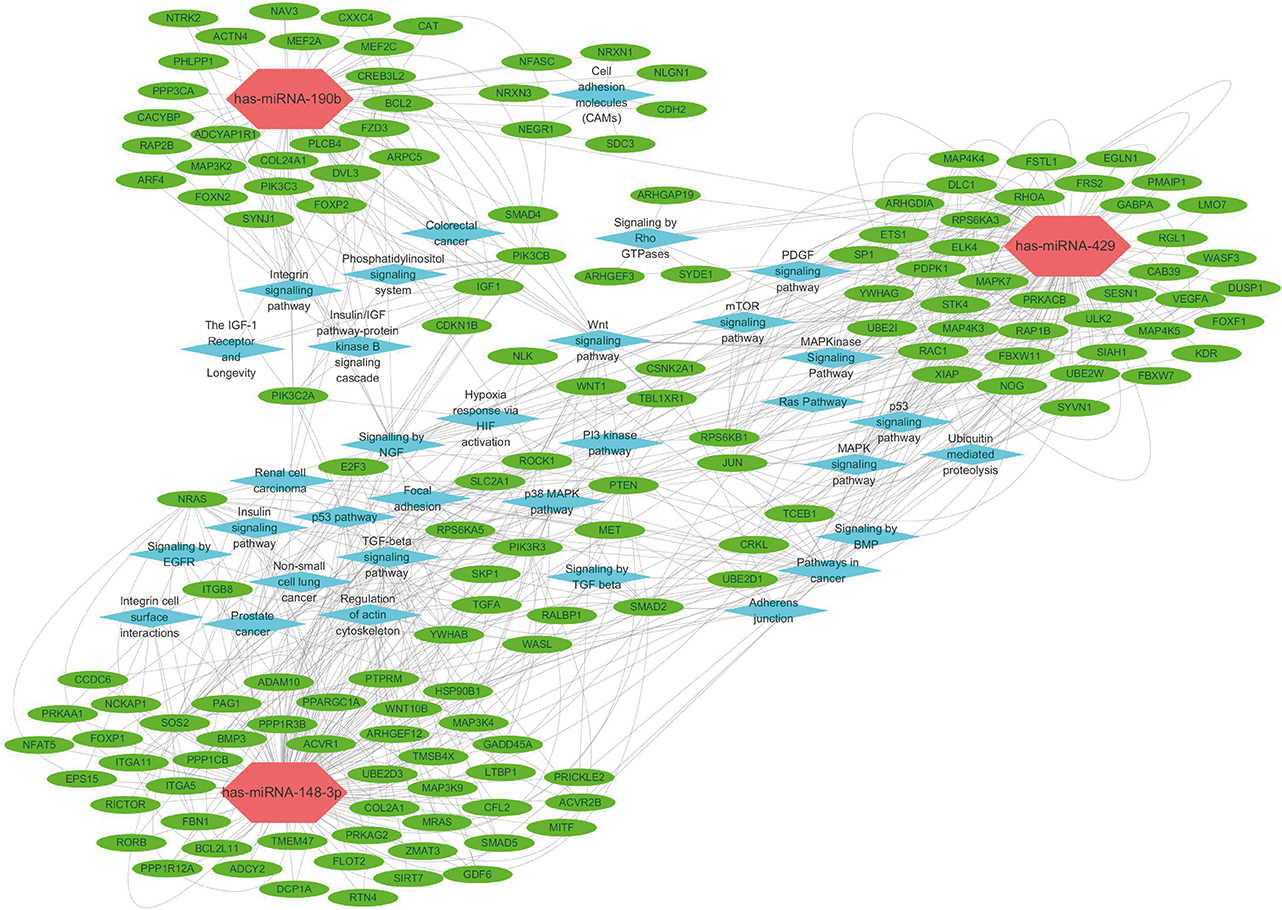J Breast Cancer.
2019 Jun;22(2):219-236. 10.4048/jbc.2019.22.e19.
miR-148b-3p, miR-190b, and miR-429 Regulate Cell Progression and Act as Potential Biomarkers for Breast Cancer
- Affiliations
-
- 1Laboratory of Molecular Genetics of Aging & Tumor, Medical School, Kunming University of Science and Technology, Yunnan, China. shengmm@aliyun.com
- 2Department of Mammary Gland and Thyroid Disease, First People's Hospital of Yunnan Province, Yunnan, China.
- KMID: 2450117
- DOI: http://doi.org/10.4048/jbc.2019.22.e19
Abstract
- PURPOSE
Breast cancer is the most frequently diagnosed malignancy in women worldwide. MicroRNAs (miRNAs) are thought to serve as potential biomarkers in various cancers, including breast cancer.
METHODS
We evaluated the miRNA expression profiles in 1,083 breast cancer samples and 104 normal breast tissues from The Cancer Genome Atlas database. We used the edgeR package of R software to analyze the differentially expressed miRNAs in normal and cancer tissues, and screened survival-related miRNAs by Kaplan-Meier analysis. A receiver operating characteristic curve was generated to evaluate the accuracy of these miRNAs as molecular markers for breast cancer diagnosis. Furthermore, the functional role of these miRNAs was verified using cell experiments. Targets of candidate miRNAs were predicted using 9 online databases, and Gene Ontology (GO) functional annotation and pathway analyses were conducted using Database for Annotation, Visualization and Integrated Discovery online tool.
RESULTS
A total of 68 miRNAs showed significantly different expression patterns between the groups (p < 0.001), and 13 of these miRNAs were significantly associated with poor survival (p < 0.05). Three miRNAs with high specificity and sensitivity, namely, miR-148b-3p, miR-190b, and miR-429, were selected. In vitro experiments showed that the overexpression of these 3 miRNAs significantly promoted the proliferation and migration of MDA-MB-468 and T47D cells and reduced the apoptosis of T47D cells. GO and pathway enrichment analyses revealed that the targets of these dysregulated miRNAs were involved in many critical cancer-related biological processes and pathways.
CONCLUSION
The miR-148b-3p, miR-190b, and miR-429 may serve as potential diagnostic and prognostic markers for breast cancer. This study demonstrated the roles of these 3 miRNAs in the initiation and progression of breast cancer.
MeSH Terms
Figure
Reference
-
1. Schneider AP 2nd, Zainer CM, Kubat CK, Mullen NK, Windisch AK. The breast cancer epidemic: 10 facts. Linacre Q. 2014; 81:244–277.
Article2. Fan L, Strasser-Weippl K, Li JJ, St Louis J, Finkelstein DM, Yu KD, et al. Breast cancer in China. Lancet Oncol. 2014; 15:e279–e289.
Article3. Liu YR, Jiang YZ, Xu XE, Hu X, Yu KD, Shao ZM. Comprehensive transcriptome profiling reveals multigene signatures in triple-negative breast cancer. Clin Cancer Res. 2016; 22:1653–1662.
Article4. Carthew RW, Sontheimer EJ. Origins and mechanisms of miRNAs and siRNAs. Cell. 2009; 136:642–655.
Article5. Tutar Y. miRNA and cancer; computational and experimental approaches. Curr Pharm Biotechnol. 2014; 15:429.6. Yang Y, Qu A, Zhao R, Hua M, Zhang X, Dong Z, et al. Genome-wide identification of a novel miRNA-based signature to predict recurrence in patients with gastric cancer. Mol Oncol. 2018; 12:2072–2084.
Article7. Harquail J, Benzina S, Robichaud GA. MicroRNAs and breast cancer malignancy: an overview of miRNA-regulated cancer processes leading to metastasis. Cancer Biomark. 2012; 11:269–280.
Article8. Iorio MV, Casalini P, Piovan C, Braccioli L, Tagliabue E. Breast cancer and microRNAs: therapeutic impact. Breast. 2011; 20:Suppl 3. S63–S70.
Article9. Li HY, Liang JL, Kuo YL, Lee HH, Calkins MJ, Chang HT, et al. miR-105/93-3p promotes chemoresistance and circulating miR-105/93-3p acts as a diagnostic biomarker for triple negative breast cancer. Breast Cancer Res. 2017; 19:133.
Article10. Siegel RL, Miller KD, Jemal A. Cancer statistics, 2016. CA Cancer J Clin. 2016; 66:7–30.
Article11. Gao Y, Cai Q, Huang Y, Li S, Yang H, Sun L, et al. MicroRNA-21 as a potential diagnostic biomarker for breast cancer patients: a pooled analysis of individual studies. Oncotarget. 2016; 7:34498–34506.
Article12. Chen X, Wang YW, Zhu WJ, Li Y, Liu L, Yin G, et al. A 4-microRNA signature predicts lymph node metastasis and prognosis in breast cancer. Hum Pathol. 2018; 76:122–132.
Article13. Yao L, Liu Y, Cao Z, Li J, Huang Y, Hu X, et al. MicroRNA-493 is a prognostic factor in triple-negative breast cancer. Cancer Sci. 2018; 109:2294–2301.
Article14. Xiong DD, Lv J, Wei KL, Feng ZB, Chen JT, Liu KC, et al. A nine-miRNA signature as a potential diagnostic marker for breast carcinoma: an integrated study of 1,110 cases. Oncol Rep. 2017; 37:3297–3304.
Article15. Yin Y, Shen C, Xie P, Cheng Z, Zhu Q. Construction of an initial microRNA regulation network in breast invasive carcinoma by bioinformatics analysis. Breast. 2016; 26:1–10.
Article16. Cizeron-Clairac G, Lallemand F, Vacher S, Lidereau R, Bieche I, Callens C. MiR-190b, the highest up-regulated miRNA in ERα-positive compared to ERα-negative breast tumors, a new biomarker in breast cancers? BMC Cancer. 2015; 15:499.
Article17. Aure MR, Leivonen SK, Fleischer T, Zhu Q, Overgaard J, Alsner J, et al. Individual and combined effects of DNA methylation and copy number alterations on miRNA expression in breast tumors. Genome Biol. 2013; 14:R126.
Article18. Li D, Wang H, Song H, Xu H, Zhao B, Wu C, et al. The microRNAs miR-200b-3p and miR-429-5p target the LIMK1/CFL1 pathway to inhibit growth and motility of breast cancer cells. Oncotarget. 2017; 8:85276–85289.
Article19. Cuk K, Zucknick M, Heil J, Madhavan D, Schott S, Turchinovich A, et al. Circulating microRNAs in plasma as early detection markers for breast cancer. Int J Cancer. 2013; 132:1602–1612.
Article20. Mangolini A, Ferracin M, Zanzi MV, Saccenti E, Ebnaof SO, Poma VV, et al. Diagnostic and prognostic microRNAs in the serum of breast cancer patients measured by droplet digital PCR. Biomark Res. 2015; 3:12.
Article21. Cimino D, De Pittà C, Orso F, Zampini M, Casara S, Penna E, et al. miR148b is a major coordinator of breast cancer progression in a relapse-associated microRNA signature by targeting ITGA5, ROCK1, PIK3CA, NRAS, and CSF1. FASEB J. 2013; 27:1223–1235.
Article22. Joshi T, Elias D, Stenvang J, Alves CL, Teng F, Lyng MB, et al. Integrative analysis of miRNA and gene expression reveals regulatory networks in tamoxifen-resistant breast cancer. Oncotarget. 2016; 7:57239–57253.
Article23. de Anda-Jáuregui G, Espinal-Enríquez J, Drago-García D, Hernández-Lemus E. Nonredundant, highly connected microRNAs control functionality in breast cancer networks. Int J Genomics. 2018; 2018:9585383.
Article24. Naorem LD, Muthaiyan M, Venkatesan A. Identification of dysregulated miRNAs in triple negative breast cancer: a meta-analysis approach. J Cell Physiol. Epub 2018 Nov 29. https://doi.org/10.1002/jcp.27839.
Article25. Patel N, Garikapati KR, Makani VK, Nair AD, Vangara N, Bhadra U, et al. Regulating BMI1 expression via miRNAs promote mesenchymal to epithelial transition (MET) and sensitizes breast cancer cell to chemotherapeutic drug. PLoS One. 2018; 13:e0190245.
Article26. Tryndyak VP, Beland FA, Pogribny IP. E-cadherin transcriptional down-regulation by epigenetic and microRNA-200 family alterations is related to mesenchymal and drug-resistant phenotypes in human breast cancer cells. Int J Cancer. 2010; 126:2575–2583.
Article27. Burk U, Schubert J, Wellner U, Schmalhofer O, Vincan E, Spaderna S, et al. A reciprocal repression between ZEB1 and members of the miR-200 family promotes EMT and invasion in cancer cells. EMBO Rep. 2008; 9:582–589.
Article28. Choi SK, Kim HS, Jin T, Hwang EH, Jung M, Moon WK. Overexpression of the miR-141/200c cluster promotes the migratory and invasive ability of triple-negative breast cancer cells through the activation of the FAK and PI3K/AKT signaling pathways by secreting VEGF-A. BMC Cancer. 2016; 16:570.
Article29. Yu SJ, Hu JY, Kuang XY, Luo JM, Hou YF, Di GH, et al. MicroRNA-200a promotes anoikis resistance and metastasis by targeting YAP1 in human breast cancer. Clin Cancer Res. 2013; 19:1389–1399.
Article30. Jin T, Suk Kim H, Ki Choi S, Hye Hwang E, Woo J, Suk Ryu H, et al. microRNA-200c/141 upregulates SerpinB2 to promote breast cancer cell metastasis and reduce patient survival. Oncotarget. 2017; 8:32769–32782.
Article
- Full Text Links
- Actions
-
Cited
- CITED
-
- Close
- Share
- Similar articles
-
- miR-205 and miR-200c: Predictive Micro RNAs for Lymph Node Metastasis in Triple Negative Breast Cancer
- MiR-103a-3p Contributes to the Progression of Colorectal Cancer by Regulating GREM2 Expression
- LncRNA XLOC_006390 facilitates cervical cancer tumorigenesis and metastasis as a ceRNA against miR-331-3p and miR-338-3p
- MiR-148a-3p Regulates the Invasion and Odontoblastic Differentiation of Human Dental Pulp Stem Cells via the Wnt1/β-Catenin Pathway
- Saturated fatty acid-inducible miR-103-3p impairs the myogenic differentiation of progenitor cells by enhancing cell proliferation through Twinfilin-1/F-actin/YAP1 axis

